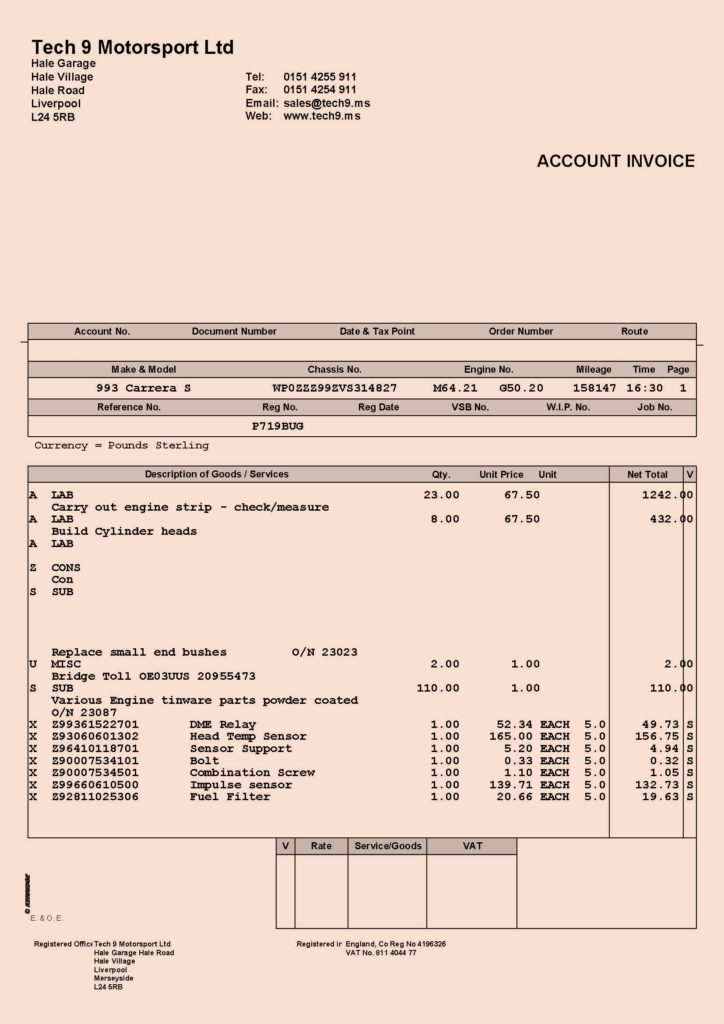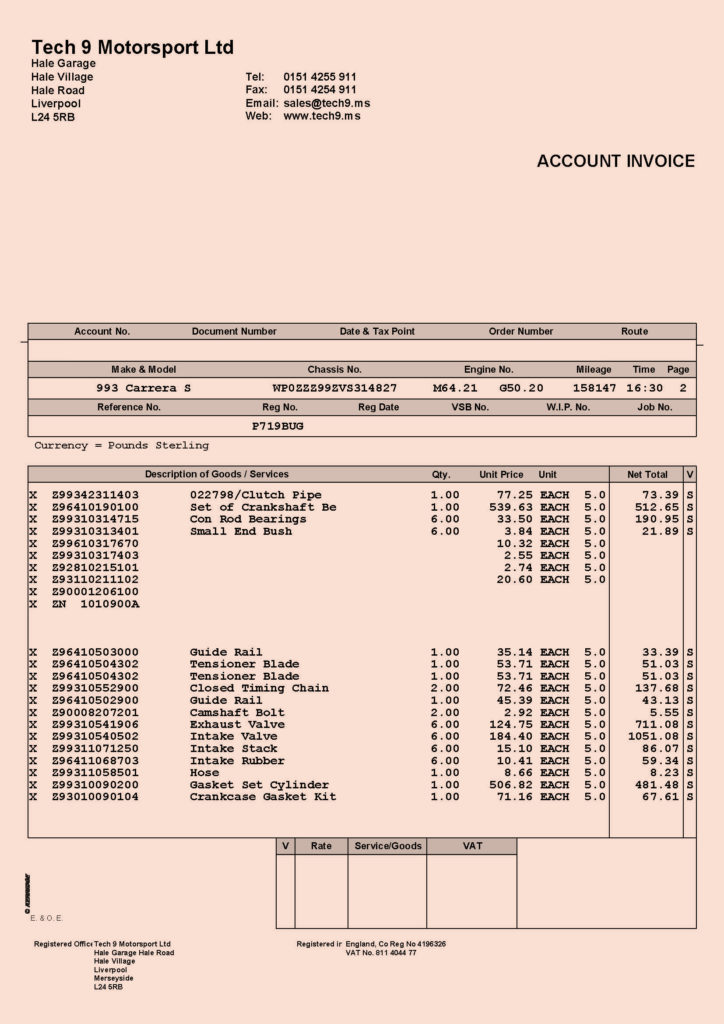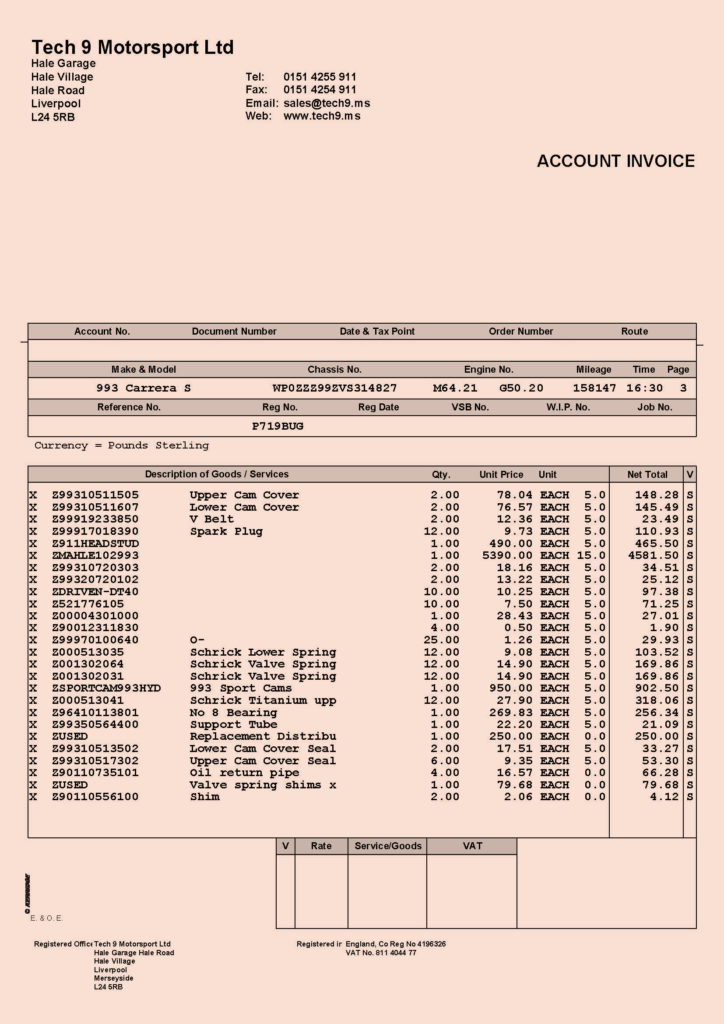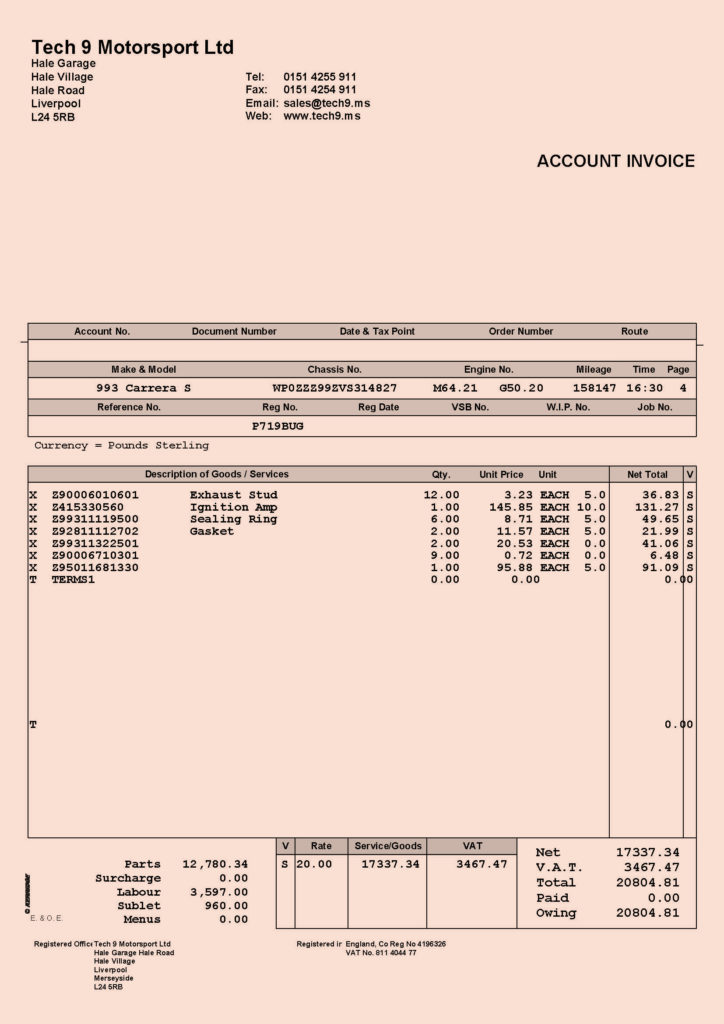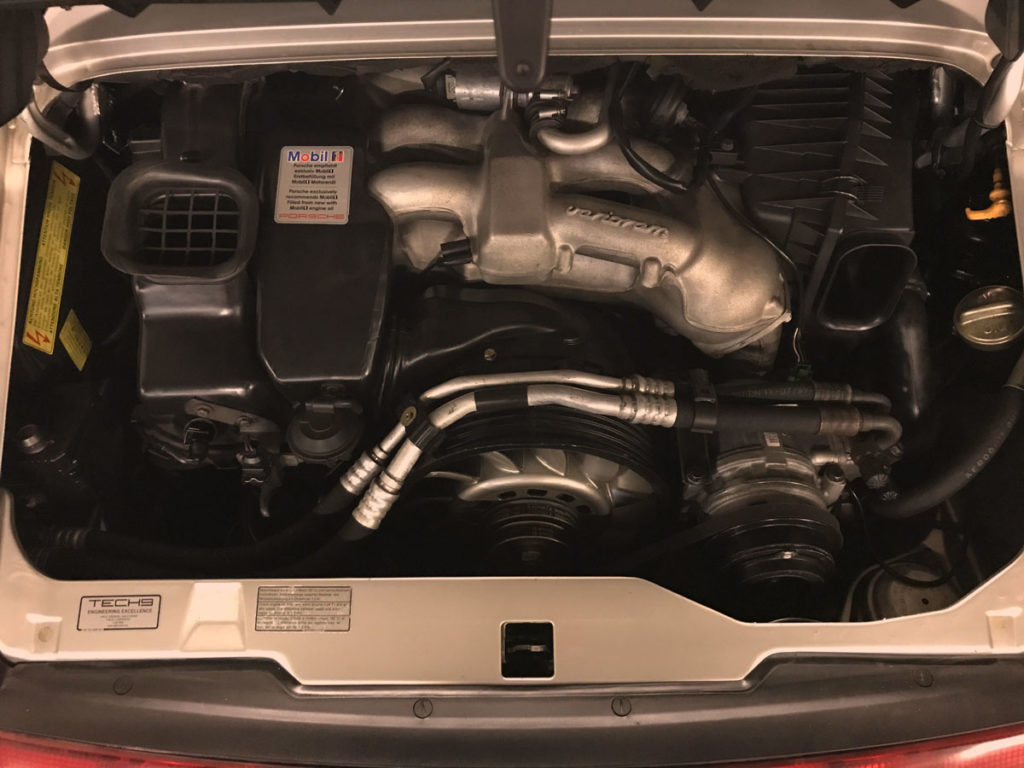
993 engines are supposedly bulletproof. Why a re-build?
Soon after collecting the car as its new owner I’d realised the leaks and consumption were far more evident than I’d been led to believe by the pre-purchase inspection. The floor where the car is stored soon became peppered with black drips and oil consumption was close to the Porsche 993 handbook tolerance limit, incredibly it still drove well.
A leak down test presented 80% leakage through the exhaust valve on cylinder 5 (what later turned out to be a badly burnt exhaust valve once the engine was opened up) and it was clear the exhaust valve on cylinder 5 would meet a miserable end if not attended to and could well cause more damage in the death throes.
Top end, or full re-build?
993 top end re-builds are common at what can be quite low mileage. There happened to be one on the bench at Tech 9 when mine was being worked on with a little more than 60,000 miles. The heat generated by the air cooled engine design puts a lot of strain on the exhaust valves which ultimately become burnt or fail. On the other hand the bottom ends are known for longevity covering high mileage. A re-seal was an option but ultimately would be a waste of money. A top end at 150,000 miles would be a half job as it would not resolve all the leaks. Arguably the proper thing to do given there was oil leaking from all the known places (chain housings, power steering pump housing and cam covers, through bolts) would be to split the engine case and do a full re-build.
It is not cheap re-building one of these engines, and the thought of building one, spending lots of money to get something back that is not visible to the eye and makes little difference other than not having any leaks isn’t that appealing. When people split the engine case to do a full re-build, the pistons and cylinders are checked and if they are in good shape and within tolerance re-used, and if not replaced with new. In good shape or not you have the option to swap out the 3.6 ones for bigger 3.8 (or 4.0). Getting a 3.8 is a lot more interesting than simply re-building the same engine you already have.
Which 993 engine builder?
Choosing an engine builder for a 993 (964, any air or water cooled Porsche 911) needs to be taken seriously. It’s a big, expensive job. You don’t want to do it all over again because someone didn’t know what they were doing, or cut corners. There are plenty of companies who specialise in 911 engine re-builds but only a handful have a first class reputation, who are building them every week of the year, with a waiting list to get a flat 6 onto their work bench. I chose to compare Nine excellence (9e) in Horley, Surrey with Tech 9 Motorsport in Hale just outside Liverpool. Both well known for quality re-builds. 9e had the advantage of being reasonably local, Tech 9 had a compelling recommendation from a good friend who’s re-built a few cars with them (including one I used to own). I warmed to them when I visited their workshop and decided this was the place for me.
Cost and time estimates
Pricing for the project was broadly similar. It is not easy to accurately pin down cost as the true extent of what needs doing can’t be fully determined until the engine is out of the car and opened up. The temptation to upgrade and replace once the work commences will also be a factor. The median costing estimates roughly as follows:
| Build level | £ (inc VAT) |
| Engine re-seal Dependent on leak areas | 1,000 – 4,200 |
| Top end re-build Labour and basics: not including all parts | 8,000 |
| Full re-build Labour and basics: not including all parts | 12,500 |
| 3.8 Full re-build + additional parts/machining | See supporting material |
Costs for the 3.8 vary depending on specification. I was initially going to go for 3.8 and not look for additional power from the cams (or elsewhere). Who makes the pistons and cylinders offers price differences (Mahle ones as used by Porsche are around £5k). How far you go will dictate the spend – deciding what’s necessary will always stop with the owner as each build is personal.
Timings for the full 3.8 build were quoted at 6-8 weeks once the engine is out of the car. Parts like the Mahle 102mm pistons and cylinders care shipped over from the USA, sub-contractors are involved in processes such as machining the engine case, parts availability, customs, other peoples work load and so on all add up. And there is a huge amount of labour. Running the car in is also a factor as this is done by the engine builder.
Option code X51
When the 993 was in manufacture in the 1990s it was possible to specify an X51 option code from the factory – the 3.8 X51 engine was pretty much what went into the 993 RS without the RS cams. All other 993s except the RS and ones with X51 were 3.6 liters. It was expensive and didn’t deliver a lot more power, perhaps explaining why there are hardly any of them. The X51 conversion kit used to be available from Porsche to retro fit but availability stopped some years ago.
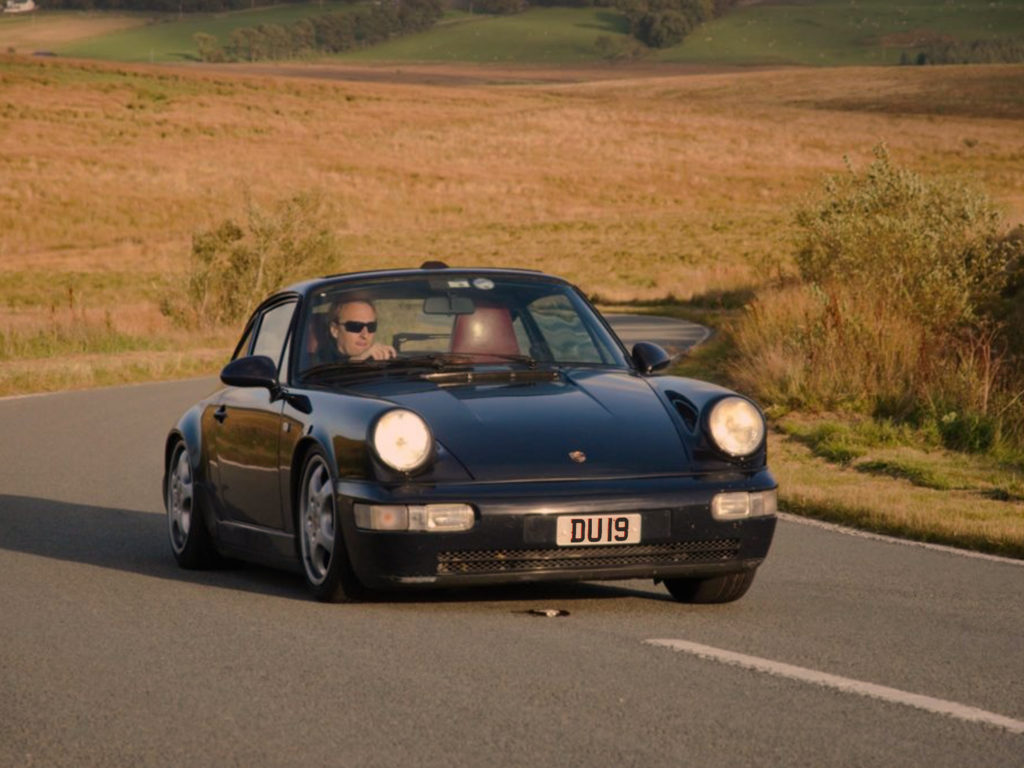
964 at the EVO Triangle 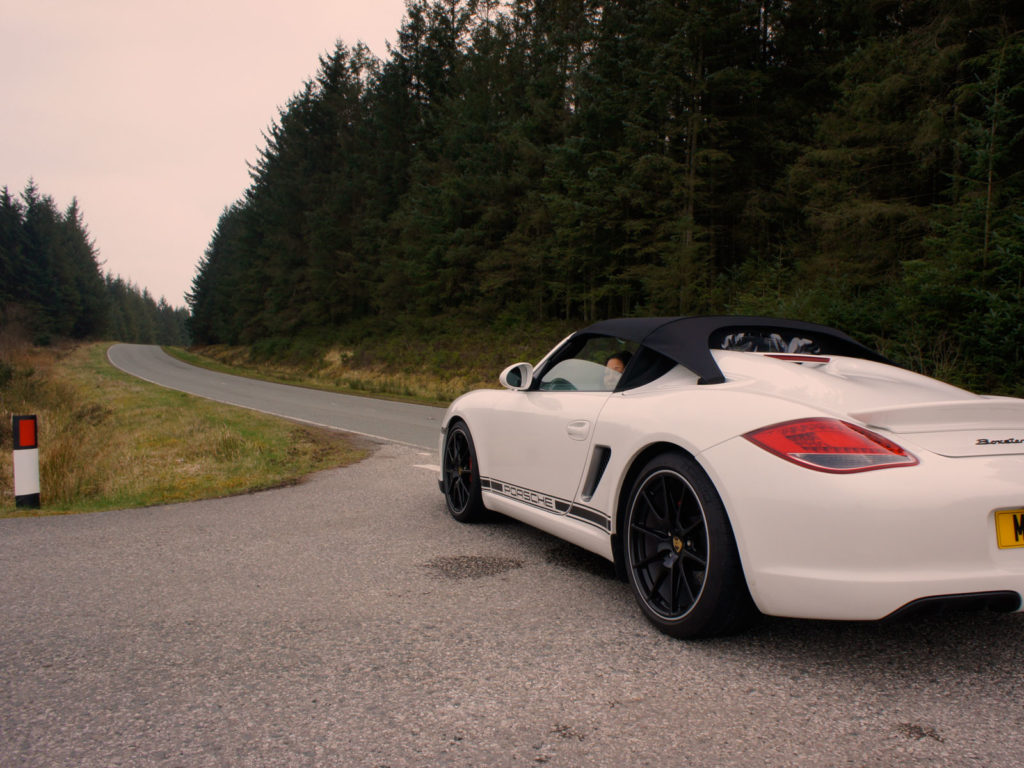
Spyder at the EVO Triangle
The 3.8 993 engine build brief
A quicker 993 with noticeably more ‘go’. I knew what I wanted from the car; something capable of crossing Europe at pace in comfort, a quick car on A and B roads that would also hang off the back of modern stuff on an Autobahn, and it needed to be happy in London’s slow crawling traffic.
One of the reference points for building the engine was based around my experience of owning a Porsche 964 C2 and a Porsche 987 Boxster Spyder – a more powerful, lightweight offering from Stuttgart reviewed as one of the best cars Porsche has built in recent years. When I got the Spyder I took it straight out to the EVO Triangle in North Wales, a place the 964 knew its way around, and it didn’t actually ‘feel’ that much more powerful. It was clearly faster but that was down to the way the drove and the confidence it inspired allowing me to push it harder. When I bought the 993 the difference was dramatic and my perception was the 993 being a far slower car despite looking similar on paper. The goal was to make this 993 with all its charm and personality deliver a comparable ‘feeling’ of pace to a 987 Spyder.
I left specifying the build to Tech 9 based on that brief and followed their guidance on focusing the work towards a great road car with lots of torque, and resisting the temptation to chase big BHP numbers.
Summary 993 3.8 engine re-build spec
Upgrades
• Mahle 3.8 pistons and cylinders (same ones used by Porsche)
• The casing machined to accept the new 102mm pistons and cylinders
• Tech 9 rally profile cams
• Uprated cylinder head studs
• Replacement of the original slotted cam chain drive wheels for more accurate ‘vernier style’ drive wheels allowing accurate cam timing, and more importantly the ability to match both banks very accurately
• Lightweight titanium valve retainers
• High quality steel valve springs, matched to the cam profile for accurate valve control
Re-build
Everything replaced and renewed, including:
• Restoring the heads
• Vapor blasting
• Cam covers
• Belts
• Filters
• O rings
• Bearings
• Seals
• Gaskets
• Studs
• Chains
• Valves
The process
Along the way the the Tech 9 team kept me informed of the progress every week, usually by an email explaining where they were with supporting photos uploaded to a Flickr gallery. The specification changed slightly along the way when they suggested the best way for me to achieve my goals would be to add some Tech 9 rally cams, and given one of my existing cams was showing signs of pitting I’d be spending some money in this area anyway. I felt involved in the process, none of it was a mystery and I quite enjoyed getting a regular update to read. The re-build was delivered in seven weeks, right in the middle of the six to eight week estimate.
Some of the photos from the 993 3.8 build process
The numbers
320bhp with 292ft/lbs (395Nm) of torque (217bhp per tonne)
Hollowspokes, LWF not deducted
For reference:
• A standard 993S is 281bhp with 251ft/lbs (340Nm). 1,475 kg
• A 993 RS 296bhp with 262ft/lbs (355Nm). 1,270kg
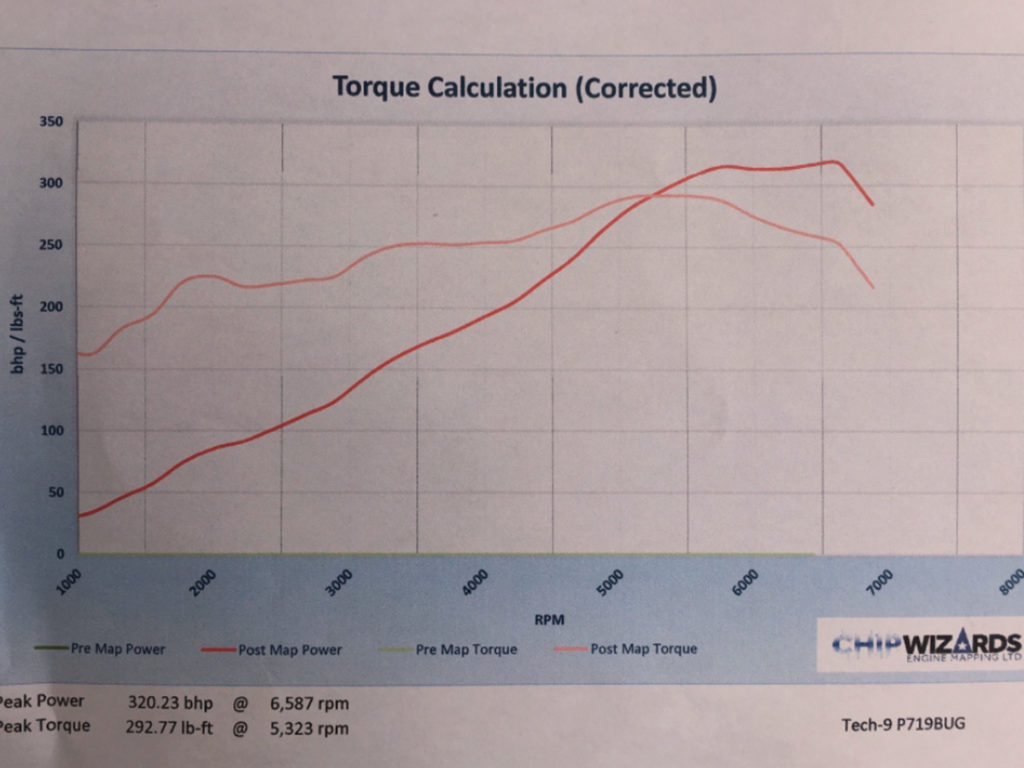

A significant increase over a 993 RS…
…however, the 993S weighs more then the RS at 1,475 kg (217bhp per tonne) vs 1,270kg (233bhp per tonne). A set of sports cats could possibly add a further 5-7bhp, and reduce weight a little further. The lightweight flywheel, hollow spoke wheels and better shocks also reduce the total kg figure but bits are also added too such as the Big Red brakes from the 993 Turbo. With a little more effort the gap should be less than 10bhp per tonne.
Actual acceleration times I can’t comment on because I have no data prior to the work so an iPhone app comparison would be meaningless. A top speed would also be meaningless without sufficient pre-build data.
MPG has increased a fraction. It probably returns one or two less to the gallon on a long open run. The best I’ve managed post build is around 28-29 MPG, where before I’ve seen 30-31 MPG. In reality, with the way I drive it, I achieve 24-25 MPG, consistent with what I’d get before the build. Around the city I’ve not noticed any change.
The lightweight RS will never be matched by a car almost 200kg heavier, but where this car now sits is an ideal compromise in my view. The stunning wide body look, air conditioning, reclining sports seats, sunroof, carpets, stereo, rear wiper, electric windows, sound proofing are all comforts that make driving from London to somewhere like the South of France enjoyable.
What’s it like to drive?
B road assessment
As excited as I was about rebuilding the 993 to a meatier 3.8, at the back of my mind was some doubt this change would not be as marked as hoped. That I’d spend a small fortune creating my ideal car only to be wishing I hadn’t bothered. Collecting the completed car from Liverpool I detoured via North Wales and headed out to the amazing B4391 from Ffestiniog and the A4212 towards Bala. A great place to compare familiar old with new. It didn’t disappoint.

The car is so much more alive. On those Welsh roads I had to make a mental note to watch my braking points as I was arriving at apexes carrying more speed than before, and in a couple of places I was able to drift the car out of corners entering them slower and burying the throttle. The car asks for respect now and it is certainly more engaging. It is fun to hustle along B roads but that’s as much down to the chassis, suspension set up, and size of the 993 than the engine alone. Having extra power and torque just makes it even better.
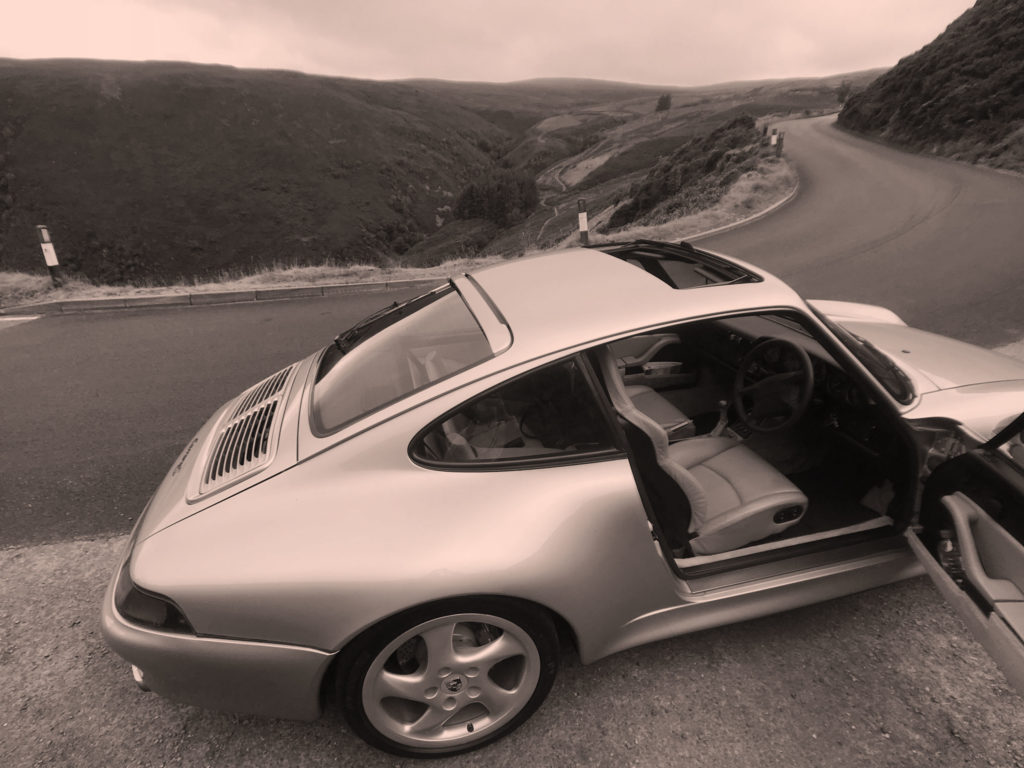
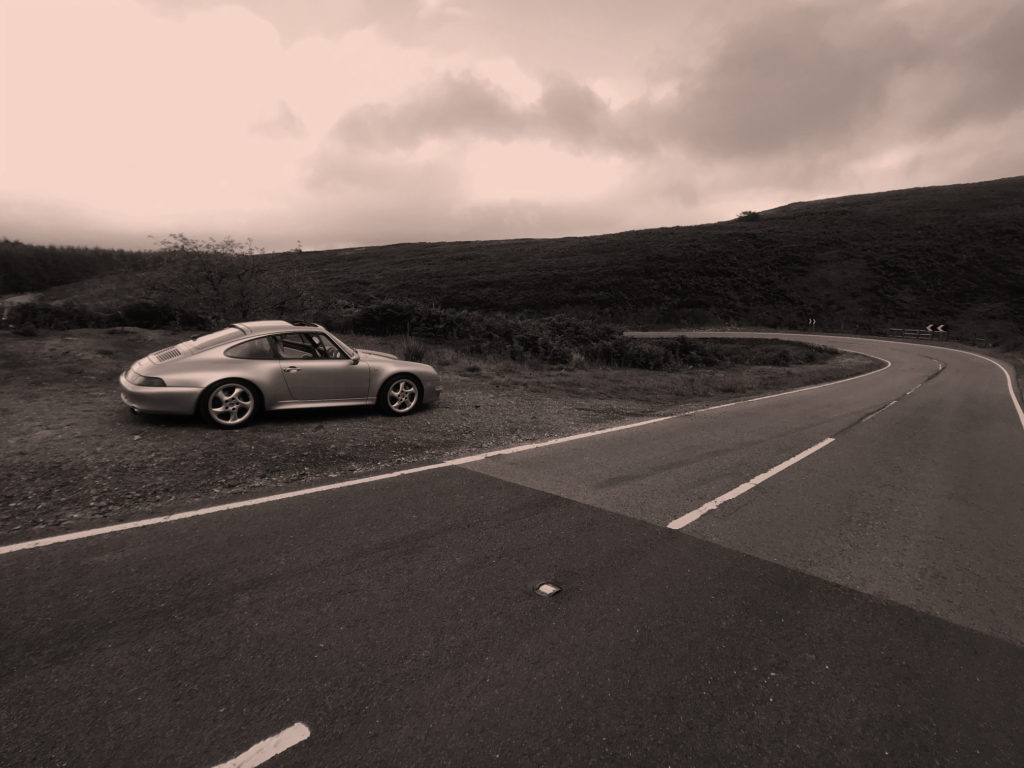
A road assessment
The next day I took it to the South West. Cornwall isn’t blessed with the best drivers roads in the country and despite its beauty is largely barren of good asphalt with the roads constantly busy and often narrow. Tourists, caravaners, horses, cyclists, farm machinery and workmen in a hurry all share the same space, and why the Abarth 500 has become my first choice when I go there. There is a decent stretch on the B3306 between Zennor and St Just if you can get to it on a clear day, and other little bits here and there but overall it’s no road testing paradise. The journey to and from does offer some fast road sections such as the A303 and A30 and these formed my part of my basis for evaluation. There and back the car was fully laden, two people, one dog, luggage and a small but heavy Gaggia coffee machine.

Overtaking in this car is unmistakably easier. By way of example, one particular overtake stands out, a three lane section closing back to two lanes uphill with cars in front blocking the passing lane. Up at the head of the queue was an articulated lorry, by the time the passing lane cleared as people scrambled to get back in line before the road narrowed there were a few cars to pass between the Waitrose warehouse delivery and a clear stretch of what would become a much twistier and narrower run with scarce overtaking opportunities. Having had a week familiarising with the car I knew it had plenty enough to get in front of everyone and the lorry, so with a mutter of “seriously?!” from the passenger seat we flew safely past everyone, touching the white cross hatching as the lane disappeared. I wouldn’t have attempted this in 3.6 guise. The power and torque of the 3.8 gives it enough of an advantage to make good progress alongside modern traffic (some quite ordinary cars are now quick cars), and you are still able to push the car’s limits reasonably acceptably on UK roads – something the current generation of faster, high grip 911s (or most high end sports cars) can no longer claim. The 3.8 993 sits in a sweet spot.
Back in London there is a run I use often, in fact there was a time when I used to drive it daily so it’s like a book to me. The Initial section along the A2016 to Belvedere and then the A206 between Bob Dunn Way and the Dartford Crossing are open dual carriageways with good visibility, punctuated with roundabouts. With the car empty of luggage and no passenger a true indication of the differences between 3.6 and 3.8 could be appraised. Without doubt, this is a faster 993 than the one I originally bought. Where before the car was tempered by the available power and abundance of grip, you now have to focus trail-braking into empty roundabouts and picking your point to accelerate out. The chassis and slip angles are easier to exploit and the sensation of being pushed back into the seat is stronger.
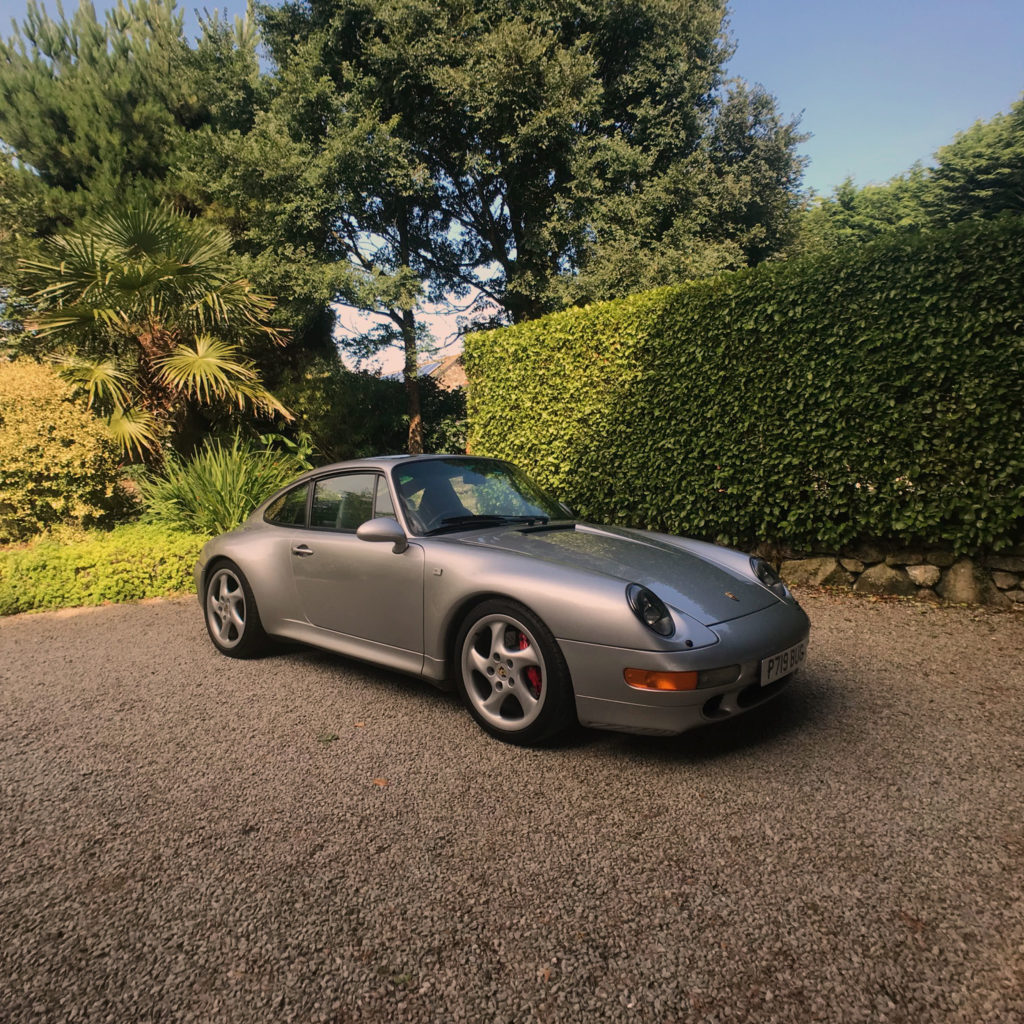
Goes as nice as it looks (finally) 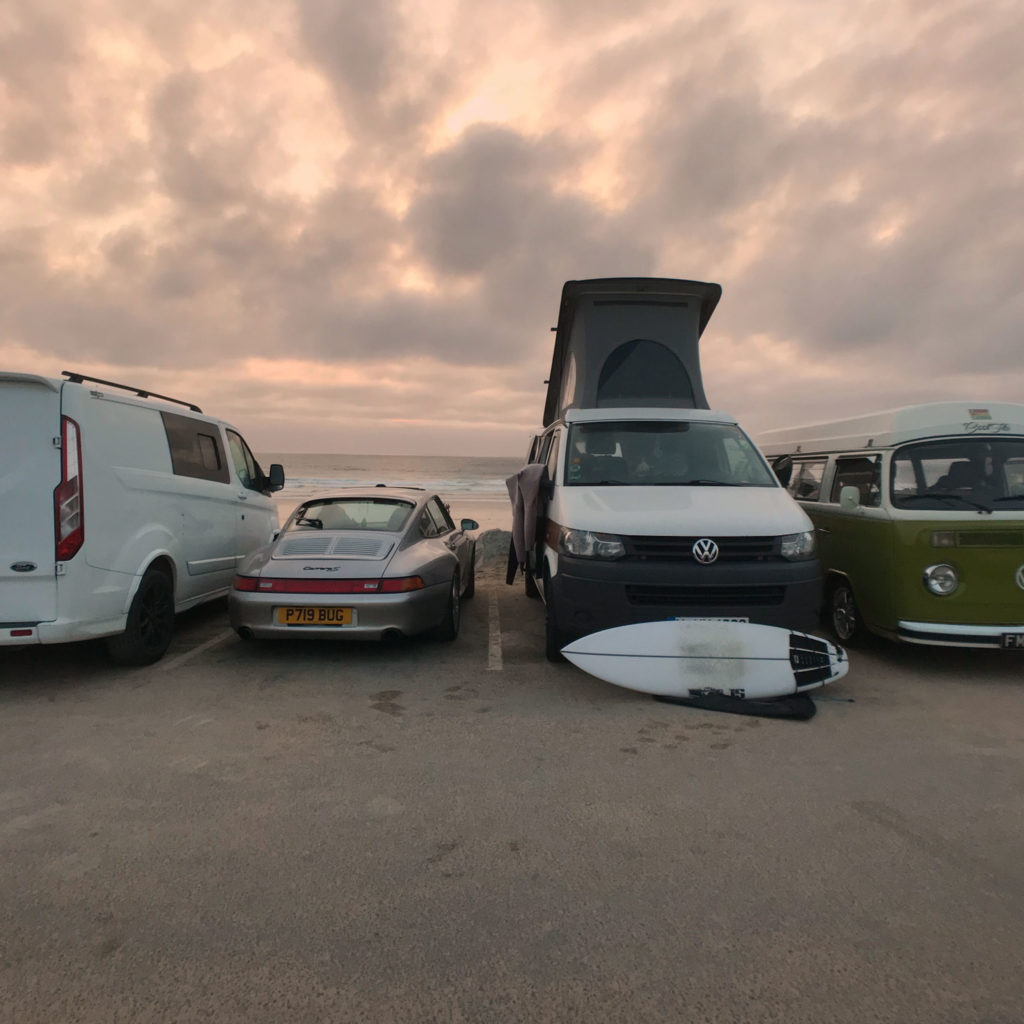
You’ll want to get past these
993 3.8 versus 997 3.8 side-by-side comparison
Hardly a scientific test, but pitching the car side-by-side with the later 997S suggested there is very little in it, if anything, until around 130mph when the water cooled car begins edging away slightly. Counts for nothing but perhaps gives a frame of reference. Some will rightfully point out you can buy a 997 for the cost of a 993 3.8 re-build, add the price of the 993 to begin with you have a car four or five times more expensive, and by my rudimentary test the 997 3.8S is quicker! That’s not the point though. I’ve driven a few 997s, being lucky enough to be let loose in them on some of the UK’s best roads and can say hand on heart, good as they are, they don’t even come close to the involvement, character and beauty of an air cooled car.
In summary
The clever bit about this 3.8 build is how nicely it drives. Lots of torque and aggressive high lift cams that are somehow so well balanced. I was apprehensive about changing the cam profiles as although they increase BHP they are also well known for making the cars idle lumpy and frustrating to drive in traffic. This car escapes these traits, a testament to Tech 9’s know-how. It has a very specific cold starting procedure where the key is turned without touching the pedals and it is then left to idle for a minute or so until the revs drop, and from this point on it behaves very close to a standard car. (don’t follow this procedure and touch the gas when starting it or while the idle is settling and you will stall constantly). Balancing the clutch on incline starts remains characteristic of light weight flywheel and RS clutch equipped 993 cars as this one is but that has nothing to do with the engine. It is an easy car to drive and a very quick 993.
There is plenty of debate online around whether or not upgrading a 993 from 3.6 to 3.8 is worthwhile. It does not deliver much by way of extra BHP, it does deliver a substantial lift in torque but at some considerable cost. Arguments range from a simple live re-map being great value for the gains they give, to re-building just the top end and adding high power cams. I re-mapped before my car was re-built and it did make more power, more importantly it found some power lost over the years making it instantly a better drive. Cams alone I can’t comment on other than my nervousness around making a lumpy, irritating to drive road car with all the excitement being high in the rev band. I don’t think it’s possible to achieve a normally aspirated 993 as good as this with a top end build only. BHP and Nm numbers don’t tell the whole story.
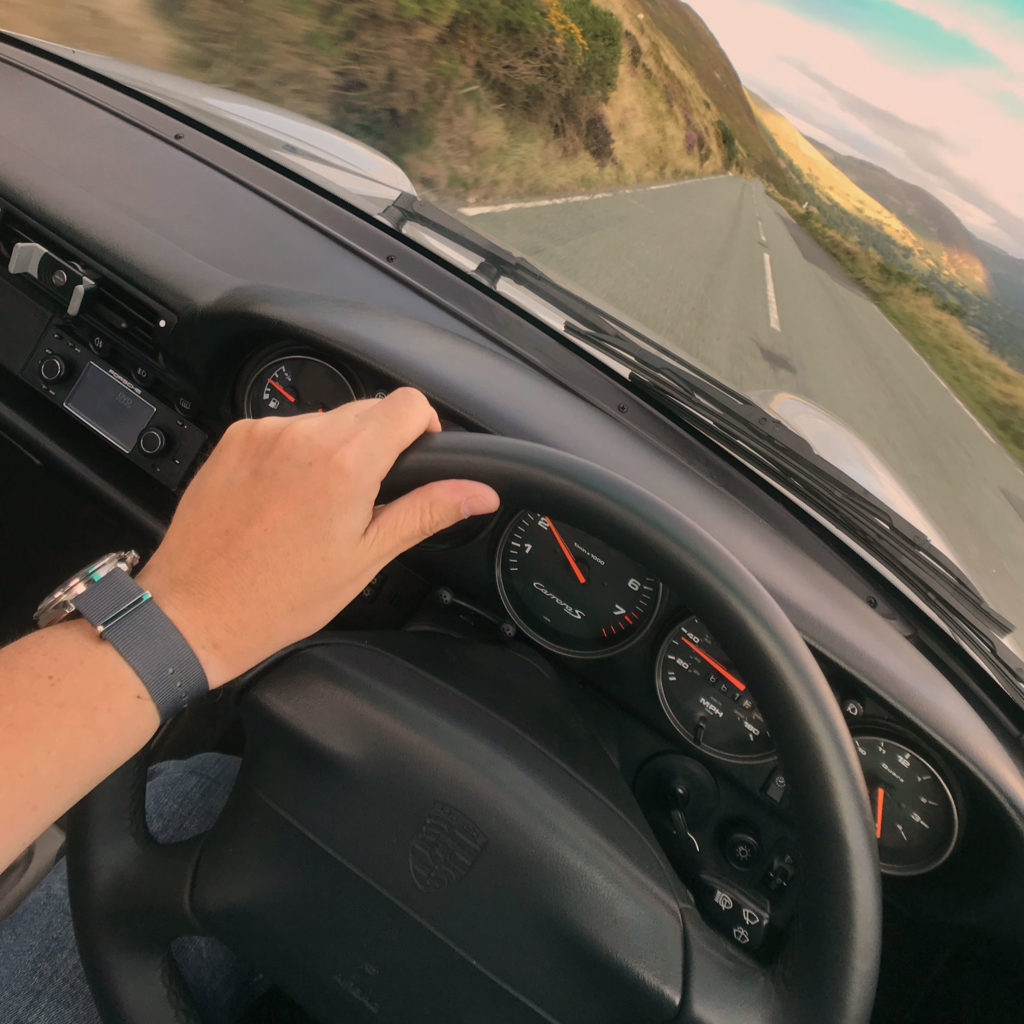
The torque is noticeably stronger. Dropping down to fourth or third to pass traffic being where this becomes most evident, the car is a lot quicker in this area, as it also is when accelerating out of corners. This is a direct result of the larger 3.8 pistons and cylinders.
The rally cams come alive at around 4,000 RPM when the Varioram kicks in and the difference over standard cams feels huge. Almost turbo like. They are nicely balanced to the engine and display no lumpiness. These are the two key changes to the engine from a factory 3.6. Combined they have made the car faster and more fun to drive. The engine is now a better match for the chassis and the power now able to bring the rear of the car into play a little – something previously harder to do given the suspension, size of the rear tyres and weight of the engine above them.
What the team at Tech 9 created is, in my opinion, an engine perfectly weighted to the 993S. They should have all left the factory like this.
Detailed engine build documentation shown below for those hungry for details. There are a few bits missing like the Vernier pulleys which made it into the engine but not onto the invoice, and a couple of items that went onto a separate invoice related to a diagnostic issue before this build was signed off. Most of it is here though and it is an accurate picture for those contemplating the 3.8.
